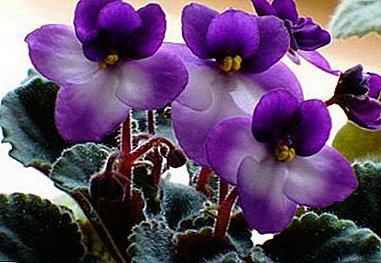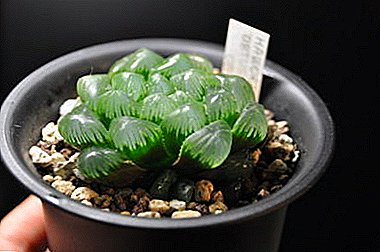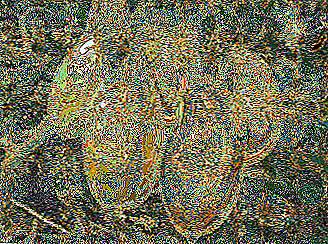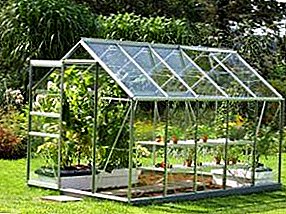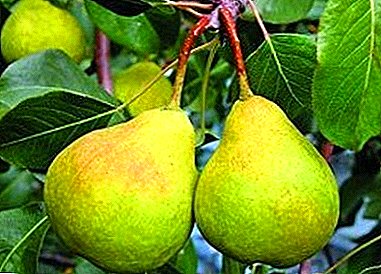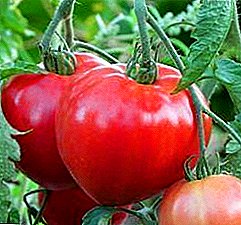 Do you want to diversify and brightly decorate landscape design near your own home? Plant broomstick. This plant will be a wonderful decoration for your yard. It will bring special joy during the flowering period: your garden will be filled not only with cheerful flowers, but also with a fragrant aroma. In addition, the broom can be used for medicinal purposes.
Do you want to diversify and brightly decorate landscape design near your own home? Plant broomstick. This plant will be a wonderful decoration for your yard. It will bring special joy during the flowering period: your garden will be filled not only with cheerful flowers, but also with a fragrant aroma. In addition, the broom can be used for medicinal purposes.
Let us consider in more detail the features of this decorative culture and the method of caring for it at home.
Botanical description
Broom is an evergreen or deciduous plant in the form of a shrub, at least - a tree from the legume family. Its leaves have a ternate, occasionally single form. The height of a mature shrub can even reach 3 meters. Often the branches of a plant are lowered, which is caused by the weight of flowers and foliage. Other names of the culture - citus, zinovat, "golden rain".
The legume family is generous to fragrant flowering plants; it is worth recalling its representatives such as acacia, certzis, sweet peas, and cobs.Today there are about 50 species of this plant, to us it "migrated" from Europe, which is its homeland.
 The decorative value of the plant is mainly in its flowers, which differ in their original form: they resemble the inflorescences of peas. The components of the flower are the triple double-lipped calyx with a sail, wings, a boat, an extended head and a brush (about 3 cm in length). Such a peculiar appearance contributes to rapid and high-quality pollination.
The decorative value of the plant is mainly in its flowers, which differ in their original form: they resemble the inflorescences of peas. The components of the flower are the triple double-lipped calyx with a sail, wings, a boat, an extended head and a brush (about 3 cm in length). Such a peculiar appearance contributes to rapid and high-quality pollination.Did you know? The plant is an excellent honey plant. From hundreds of flowers, bees can collect nectar, which contains 36.7 mg of granulated sugar.At the end of the flowering period, fruits begin to form in the form of a flattened oblong bean. One such bean can place from one to several seeds.
The bright yellow color of the flowers turns the shrub into a living flame. There are also cultures with white, pink or pale red petals. Broom blossoms in mid-spring and will delight you with their flowers until July. 
Types and varieties
The broom is distinguished by a variety of species and varieties, which are classified according to leaf cover (evergreen and deciduous), color of flowers, foliage form, growth method (shrub or tree). Consider the features of the most popular varieties and species:
- Albus Broom - one of the most common deciduous species. The branches of this culture have an arcuate shape, which contributes to the formation of a dense crown of the shrub; its height is about 1 m. During May-June, Albus is covered with delicate white pea-shaped flowers that are ahead of the appearance of foliage. The peculiarity of this species lies in its frost resistance - it withstands up to -40˚С.
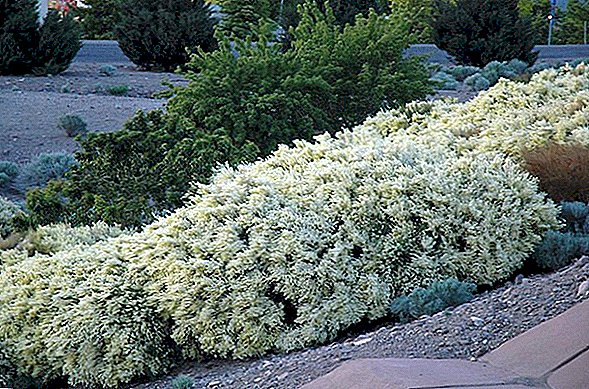
- Creeping broom - representative of the dwarf variety of this plant. Its height is only 20 cm. It is an open shrub, about 80 cm in diameter. The culture has a special beauty during flowering, when its thin branches are covered with dark yellow flowers. Not afraid of the cold. Breeding method - seeds and cuttings.
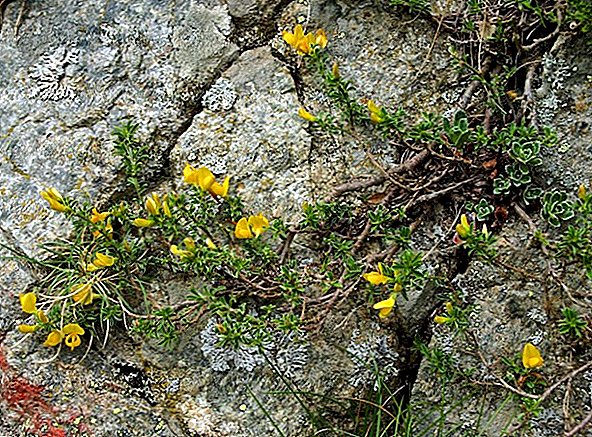
- Excellent decoration rock garden, or suburban area is crown of broom. This leafy giant plant that reaches 3 meters in height. Its feature lies in the richness of colorings of inflorescences: from yellow to red. There are even two-colored flowers (for example, a combination of yellow and red shades in the petals). It should be remembered that this variety is afraid of cold weather: its frost resistance is -20˚С.
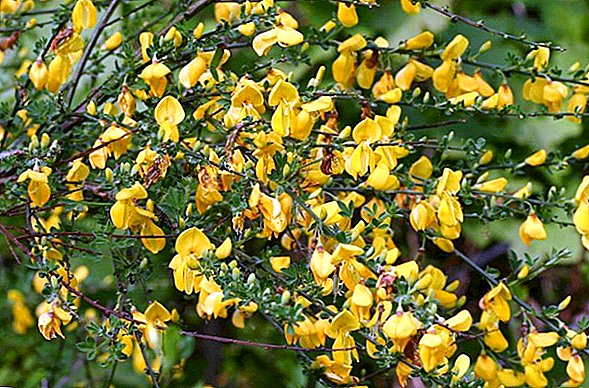
- Broom Lena - one of the species of coronet varieties, which attracts the attention with a spectacular color of flowers, which combined golden and bright red shades. The plant forms a dense shrub, about 1.3 m in height. Flowering period: end of May – beginning of June.
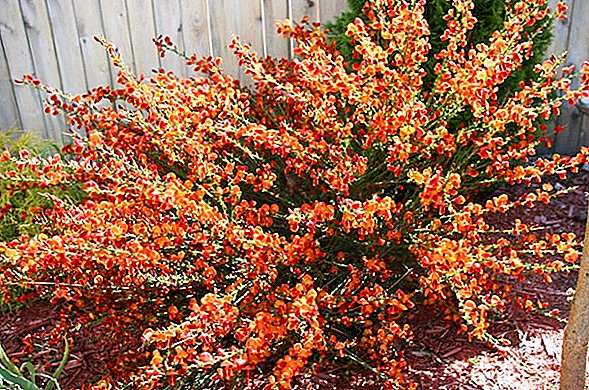
- Representatives Russian varieties endure harsh climatic conditions. Gray-green leaves of a bush are excellently combined with bright yellow florets.

- The heady aroma of sunny flowers is different early broomwhich is resistant to cold and frost.

- Caviar variety - representative of evergreen handicraft citus. Its flowers are collected in glowing yellow inflorescences.

- Representatives Cusse varieties they are distinguished by warm flowers, most often cream shades. The height of this culture is only 30-50 cm, but the diameter of the area they cover with their branches and shoots is about two meters. This view is a great decoration of rock gardens or rocky landscapes.
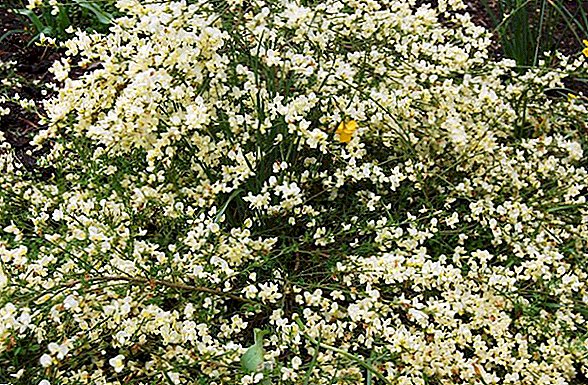
Important! Do not forget that this culture is poisonous, so after contact with it you should wash your hands thoroughly.
Choosing a place to land
Broom is not picky, but still has its whims. First of all, it concerns the choice of a seat. Everyone who wants to admire the rampant flowering of the broom should carefully examine the whims of this plant.
Lighting and location
Culture prefers places with bright but diffused sunlight, which it especially needs in the autumn-winter period. For it is extremely harmful to hit direct sunlight at noon. The morning and evening rays of the sun do not harm the bush.
If you decide to grow the plant in room conditions, put it on the window sill, located on the southeast side of the house. From time to time, plants need to be taken out to fresh air. Place for landing on the street should be warm and windless. 
Soil type
Baler prefers loose soil with a moderate degree of fertility and slightly acid or neutral reactions. It is also necessary to choose a soil with a well-established drainage system. On marshy ground or land with high acidity, the plant does not survive. Also, it is contraindicated soils on which groundwater lies close to the surface. Rare flooding of the soil bush tolerates quite bravely.
Important! It is forbidden to plant a broom near water bodies, as it is poisonous and can adversely affect the living flora of the water body.
Landing
Planting and caring for a broom in an open field is an easy task, but only on condition that you choose the right place for planting and the type of soil. Further cultivation of the shrub does not require much effort. Planting it is made by seeds or cuttings. Regardless of the method, the best time for planting (transplanting) is spring (April - May).
Seeds
Planting broom seeds can be carried out self-sowing in autumn, after ripening fruits. Seeds for growing seedlings must be sown after they are harvested, that is, in the fall, in shallow containers. For sowing, you need to prepare the tank and fill it with a mixture of sand, humus and peat (1: 2: 1). In the resulting soil mixture, place the seeds and sprinkle on top of 5 cm ball of sand, or the same mixture. Move the container with the sown seeds to a room with a temperature range from 18 to 20 ° C. After sprouting, seedlings must be dived and planted in separate pots filled with the same soil.
For sowing, you need to prepare the tank and fill it with a mixture of sand, humus and peat (1: 2: 1). In the resulting soil mixture, place the seeds and sprinkle on top of 5 cm ball of sand, or the same mixture. Move the container with the sown seeds to a room with a temperature range from 18 to 20 ° C. After sprouting, seedlings must be dived and planted in separate pots filled with the same soil.
In May, seedlings are planted in open ground. After this, it is necessary to pinch the central shoot. This action contributes to the lush growth of the bush. When landing, you must adhere to the distance - 30 cm.
If you want to grow broom in room conditions, you need to transplant it into a spacious container, the size of which will contribute to the proper functioning of the root system.
"Golden rain" bush will delight you only in the third year of life.
Did you know? Broom has powerful medicinal properties. Drugs from culture are used in the fight against diseases of the heart, circulatory, vascular, nervous systems, migraine, pulmonary tuberculosis and other diseases.

Cuttings and layering
It is also effective to propagate the broom by cuttings and layering.
- The method of grafting is as follows: in the fall, when the shrub has faded, you need to cut cuttings with 3 leaf nodes out of it. For cuttings, you need to choose semi-wrought shoots. Cuttings should be placed in a container with a sandy-peat substrate and covered with glass on top. The container should be stored in a room with a temperature of + 20˚С. It is worth remembering about regular airing and watering the plant. For 4-6 weeks, cuttings will form roots and can be transplanted into a larger container.
- If your garden is decorated with broomsticks with creeping branches, you can propagate by layering. To do this, the branches should be bent to the ground, sprinkled on top of the soil in order to provide the layers with a constant supply of moisture. Soon, the cuttings will take root, and the crouched shoots will become full-fledged seedlings that need to be separated from the maternal branch and transplanted.
How to care for a plant
Broom care includes watering, loosening the soil, feeding and pruning.
Watering and soil care
The broom does not like to be watered often, it is quite drought tolerant. To find out if he needs water, you need to monitor the upper ball of the soil and the amount of precipitation (in case of landing outside). If the soil is dry - the plant needs water.
Important! Experienced gardeners are advised to water water with a small amount of lime.The shrub care complex also includes regular but shallow soil loosening around it and removal of weeds. Loosening should be done carefully so as not to harm the rhizome.
Top dressing
Active vegetative growth depletes the broom, so at this time it must be fed. In the spring he needs the necessary nitrogen fertilizers, in the summer mineral fertilizers, especially phosphorus and potassium. It should adhere to the ratio specified in the instructions.
Wood ash is an effective means of feeding.
Pruning
The height of 3-year-old citus is 50 cm. At this age, it can already be trimmed. Pruning is an important agrotechnical method of plant care. It is recommended to carry out after flowering. Pruning the branches is necessary up to woody branches. Young shoots are advised to pinch. Such a measure contributes to the lush growth of the bush.
How to prepare broom for winter
If your plant is over 3 years old, it does not need special preparation for winter. On the same young bushes should take care. To protect young cultures from the winter cold, they are advised to cover with spruce leaves or foliage. In order to better wrap, it is necessary to chain the branches of the bush to the ground with special clips.
Possible diseases and pests
Broomstick is quite resistant to the attack of diseases and pests. But sometimes falls under their influence. The main enemies of the plant:
- spider mite leads to blanching of the leaves of the bush, depression. To eliminate such a parasite will help Fitoverm or Fufanon.
- Aphid affects absolutely all parts of the culture, leads to the deformation of leaves and flowers. Signs of the disease: yellowing and abscission of foliage, growth retardation, culture sinking. To get rid of the insect will help means containing permethrin (Aktellik, Fitoverm, Cypermethrin).
- powdery mildew on the shrubs overcome 5% copper sulfate.

Features of growing in a container
If desired, broom can be grown in room conditions. The first thing you need to implement such a goal - the choice of capacity. The container should be quite spacious for the proper development and functioning of the root system.
Important! The best soil for growing crops in room conditions - substrate of sand, humus and peat in a ratio of 1: 2: 1. Norms of lighting, temperature, irrigation and feeding are the same as for plants planted in open ground.In the summer of indoor culture must be carried out on the street. In addition, it must be regularly aired.
As you can see, the process of growing the broom does not pose any particular difficulties. You just need to follow a few rules of care. In return, culture will thank you for a generous and fragrant bloom. A landscape design with her participation looks just fine.










